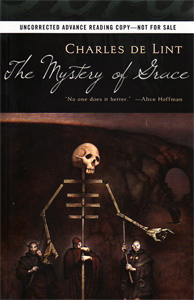I have collected advance reading copies, also described, sometimes accurately, sometimes not, as ARCs, uncorrected proofs, or bound galleys, for many years. Originally, I was drawn to them because many of the books and authors that I was interested in had their “first edition” release in mass-market paperback, and while I like mass-market paperbacks just fine for reading, they didn’t strike me in my youthful ignorance as overly exciting collectibles.
Over the years, my attitude towards these—I’ll call them “ARCs,” for the sake of convenience—has changed somewhat, and if anything I like them more now than I ever did. Talk to an ARC collector, and they’ll give you a variety of reasons for their appeal: they are the “true first edition,” preceding any other published state of a book; they represent an opportunity to read a book prior to the official publication date; and (one of my own primary considerations) they represent a version of the book that potentially differs from the one which is ultimately released.
I’ve included a photo with this posting of the ARC of Charles de Lint’s most recent novel, The Mystery of Grace, which happen(s, ed) to be running as a banner ad atop this website. Aside from any textual differences that there may be between the published version, released on March 17, 2009, and my copy (available before that time), there is one thing that leaps out at you immediately: the cover art and design used on the ARC is completely different.
More significant changes are often made between the pre-release state(s) and the published book, which calls for an explanation of the different types of “advance copies” and how they can differ. Though the terms above, and others, are sometimes used interchangably, they are not always the same thing.
Broadly, the group of terms indicates versions of a book that are released prior to the official publication date, and which differ from the published version in some material way. For books that are released in hardcover, advance copies are most often issued in large-format paperback, sometimes with cover art and sometimes with what are called “printed wrappers,” meaning plain paper with some printed text and sometimes a minor illustration or decoration. Both types may include various information points about the book itself: marketing plans, printing information, blurbs for the author or previous books, and other such. Somewhere on the front or back or both, there will be text stating that the book is a prerelease version. They also usually say “NOT FOR SALE.”
Beyond that, there are a number of factors that differentiate among the various types. An example from my own collection is Ursula K. Le Guin’s fine novel Gifts. I have two different pre-publication versions: the first, earlier version in bound in printed wrappers and stated as an “Uncorrected Proof”; the second has the final jacket art in full color (“illustrated wraps”) and states “Uncorrected Proof/Advance Reading Copy.”
As I recall, the recent Tor publication of Orson Scott Card’s Ender in Exile (Tor, November 2008) also had two different prerelease versions. The one I saw first was bound in red printed wraps and stated (I think) “Advance Bound Manuscript.” The one I have, which came along a bit later, is bound in white paper with a black and white starfield illustration on the front. This one says “Advance Uncorrected Proof.”
If I had to generalize based on my own experience, I’d say the following will give you a basic idea of the primary variants. There are more, but these are the most common. As always, there will be significant differences between publishers and even imprints; I’m not aware of any one rule that could be applied to all. I’ve set ’em out as roughly from earliest version to latest.
Bound Manuscript. Often printed directly from the author’s copy, sometimes edited to a greater or lesser degree, sometimes not. I’ve seen these with more or less book-like layouts, and I’ve seen them double-spaced, single-sided, and in Courier typeface. Bound manuscripts are also the most likely versions to be printed on letter-size (8 1/2 x 11″) paper, and are often bound differently as well.
Uncorrected Proof. This version will often have the final layout and typography that will be used for the published version in place, and may have had editing done, but is not necessarily the “final” version and may not have completed the full editorial process and author’s review.
Advance Reading Copy (ARC). May be either of the two listed above, but may also be a “finished” version of the book, if less elaborately bound and produced, created for the purpose of reviews and publicity. An ARC will often feature the finished art and design.
As I say, your experiences will vary, and there will be combinations and mashups and various iterations of these terms and others used interchangeably. Take from this what you will. If nothing else, advance copies can be a fun type of collecting, and in some cases, even a profitable one.










